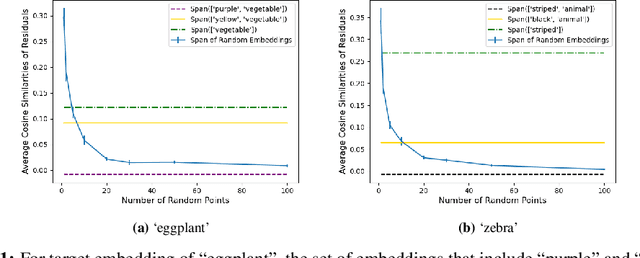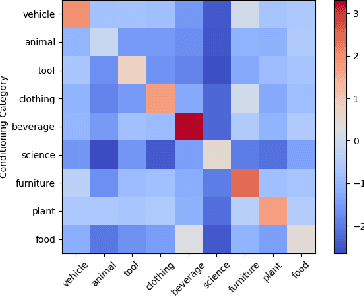Yibo Jiang
MultiCrafter: High-Fidelity Multi-Subject Generation via Spatially Disentangled Attention and Identity-Aware Reinforcement Learning
Sep 26, 2025Abstract:Multi-subject image generation aims to synthesize user-provided subjects in a single image while preserving subject fidelity, ensuring prompt consistency, and aligning with human aesthetic preferences. However, existing methods, particularly those built on the In-Context-Learning paradigm, are limited by their reliance on simple reconstruction-based objectives, leading to both severe attribute leakage that compromises subject fidelity and failing to align with nuanced human preferences. To address this, we propose MultiCrafter, a framework that ensures high-fidelity, preference-aligned generation. First, we find that the root cause of attribute leakage is a significant entanglement of attention between different subjects during the generation process. Therefore, we introduce explicit positional supervision to explicitly separate attention regions for each subject, effectively mitigating attribute leakage. To enable the model to accurately plan the attention region of different subjects in diverse scenarios, we employ a Mixture-of-Experts architecture to enhance the model's capacity, allowing different experts to focus on different scenarios. Finally, we design a novel online reinforcement learning framework to align the model with human preferences, featuring a scoring mechanism to accurately assess multi-subject fidelity and a more stable training strategy tailored for the MoE architecture. Experiments validate that our framework significantly improves subject fidelity while aligning with human preferences better.
The Illusion of Role Separation: Hidden Shortcuts in LLM Role Learning (and How to Fix Them)
May 01, 2025Abstract:Large language models (LLMs) that integrate multiple input roles (e.g., system instructions, user queries, external tool outputs) are increasingly prevalent in practice. Ensuring that the model accurately distinguishes messages from each role -- a concept we call \emph{role separation} -- is crucial for consistent multi-role behavior. Although recent work often targets state-of-the-art prompt injection defenses, it remains unclear whether such methods truly teach LLMs to differentiate roles or merely memorize known triggers. In this paper, we examine \emph{role-separation learning}: the process of teaching LLMs to robustly distinguish system and user tokens. Through a \emph{simple, controlled experimental framework}, we find that fine-tuned models often rely on two proxies for role identification: (1) task type exploitation, and (2) proximity to begin-of-text. Although data augmentation can partially mitigate these shortcuts, it generally leads to iterative patching rather than a deeper fix. To address this, we propose reinforcing \emph{invariant signals} that mark role boundaries by adjusting token-wise cues in the model's input encoding. In particular, manipulating position IDs helps the model learn clearer distinctions and reduces reliance on superficial proxies. By focusing on this mechanism-centered perspective, our work illuminates how LLMs can more reliably maintain consistent multi-role behavior without merely memorizing known prompts or triggers.
Humanity's Last Exam
Jan 24, 2025Abstract:Benchmarks are important tools for tracking the rapid advancements in large language model (LLM) capabilities. However, benchmarks are not keeping pace in difficulty: LLMs now achieve over 90\% accuracy on popular benchmarks like MMLU, limiting informed measurement of state-of-the-art LLM capabilities. In response, we introduce Humanity's Last Exam (HLE), a multi-modal benchmark at the frontier of human knowledge, designed to be the final closed-ended academic benchmark of its kind with broad subject coverage. HLE consists of 3,000 questions across dozens of subjects, including mathematics, humanities, and the natural sciences. HLE is developed globally by subject-matter experts and consists of multiple-choice and short-answer questions suitable for automated grading. Each question has a known solution that is unambiguous and easily verifiable, but cannot be quickly answered via internet retrieval. State-of-the-art LLMs demonstrate low accuracy and calibration on HLE, highlighting a significant gap between current LLM capabilities and the expert human frontier on closed-ended academic questions. To inform research and policymaking upon a clear understanding of model capabilities, we publicly release HLE at https://lastexam.ai.
Beyond Reward Hacking: Causal Rewards for Large Language Model Alignment
Jan 16, 2025



Abstract:Recent advances in large language models (LLMs) have demonstrated significant progress in performing complex tasks. While Reinforcement Learning from Human Feedback (RLHF) has been effective in aligning LLMs with human preferences, it is susceptible to spurious correlations in reward modeling. Consequently, it often introduces biases-such as length bias, sycophancy, conceptual bias, and discrimination that hinder the model's ability to capture true causal relationships. To address this, we propose a novel causal reward modeling approach that integrates causal inference to mitigate these spurious correlations. Our method enforces counterfactual invariance, ensuring reward predictions remain consistent when irrelevant variables are altered. Through experiments on both synthetic and real-world datasets, we show that our approach mitigates various types of spurious correlations effectively, resulting in more reliable and fair alignment of LLMs with human preferences. As a drop-in enhancement to the existing RLHF workflow, our causal reward modeling provides a practical way to improve the trustworthiness and fairness of LLM finetuning.
Quantifying Generalization Complexity for Large Language Models
Oct 02, 2024Abstract:While large language models (LLMs) have shown exceptional capabilities in understanding complex queries and performing sophisticated tasks, their generalization abilities are often deeply entangled with memorization, necessitating more precise evaluation. To address this challenge, we introduce Scylla, a dynamic evaluation framework that quantitatively measures the generalization abilities of LLMs. Scylla disentangles generalization from memorization via assessing model performance on both in-distribution (ID) and out-of-distribution (OOD) data through 20 tasks across 5 levels of complexity. Through extensive experiments, we uncover a non-monotonic relationship between task complexity and the performance gap between ID and OOD data, which we term the generalization valley. Specifically, this phenomenon reveals a critical threshold - referred to as critical complexity - where reliance on non-generalizable behavior peaks, indicating the upper bound of LLMs' generalization capabilities. As model size increases, the critical complexity shifts toward higher levels of task complexity, suggesting that larger models can handle more complex reasoning tasks before over-relying on memorization. Leveraging Scylla and the concept of critical complexity, we benchmark 28LLMs including both open-sourced models such as LLaMA and Qwen families, and close-sourced models like Claude and GPT, providing a more robust evaluation and establishing a clearer understanding of LLMs' generalization capabilities.
Do LLMs dream of elephants (when told not to)? Latent concept association and associative memory in transformers
Jun 26, 2024



Abstract:Large Language Models (LLMs) have the capacity to store and recall facts. Through experimentation with open-source models, we observe that this ability to retrieve facts can be easily manipulated by changing contexts, even without altering their factual meanings. These findings highlight that LLMs might behave like an associative memory model where certain tokens in the contexts serve as clues to retrieving facts. We mathematically explore this property by studying how transformers, the building blocks of LLMs, can complete such memory tasks. We study a simple latent concept association problem with a one-layer transformer and we show theoretically and empirically that the transformer gathers information using self-attention and uses the value matrix for associative memory.
The Geometry of Categorical and Hierarchical Concepts in Large Language Models
Jun 03, 2024Abstract:Understanding how semantic meaning is encoded in the representation spaces of large language models is a fundamental problem in interpretability. In this paper, we study the two foundational questions in this area. First, how are categorical concepts, such as {'mammal', 'bird', 'reptile', 'fish'}, represented? Second, how are hierarchical relations between concepts encoded? For example, how is the fact that 'dog' is a kind of 'mammal' encoded? We show how to extend the linear representation hypothesis to answer these questions. We find a remarkably simple structure: simple categorical concepts are represented as simplices, hierarchically related concepts are orthogonal in a sense we make precise, and (in consequence) complex concepts are represented as polytopes constructed from direct sums of simplices, reflecting the hierarchical structure. We validate these theoretical results on the Gemma large language model, estimating representations for 957 hierarchically related concepts using data from WordNet.
On the Origins of Linear Representations in Large Language Models
Mar 06, 2024Abstract:Recent works have argued that high-level semantic concepts are encoded "linearly" in the representation space of large language models. In this work, we study the origins of such linear representations. To that end, we introduce a simple latent variable model to abstract and formalize the concept dynamics of the next token prediction. We use this formalism to show that the next token prediction objective (softmax with cross-entropy) and the implicit bias of gradient descent together promote the linear representation of concepts. Experiments show that linear representations emerge when learning from data matching the latent variable model, confirming that this simple structure already suffices to yield linear representations. We additionally confirm some predictions of the theory using the LLaMA-2 large language model, giving evidence that the simplified model yields generalizable insights.
Direct Acquisition Optimization for Low-Budget Active Learning
Feb 08, 2024



Abstract:Active Learning (AL) has gained prominence in integrating data-intensive machine learning (ML) models into domains with limited labeled data. However, its effectiveness diminishes significantly when the labeling budget is low. In this paper, we first empirically observe the performance degradation of existing AL algorithms in the low-budget settings, and then introduce Direct Acquisition Optimization (DAO), a novel AL algorithm that optimizes sample selections based on expected true loss reduction. Specifically, DAO utilizes influence functions to update model parameters and incorporates an additional acquisition strategy to mitigate bias in loss estimation. This approach facilitates a more accurate estimation of the overall error reduction, without extensive computations or reliance on labeled data. Experiments demonstrate DAO's effectiveness in low budget settings, outperforming state-of-the-arts approaches across seven benchmarks.
Uncovering Meanings of Embeddings via Partial Orthogonality
Oct 26, 2023



Abstract:Machine learning tools often rely on embedding text as vectors of real numbers. In this paper, we study how the semantic structure of language is encoded in the algebraic structure of such embeddings. Specifically, we look at a notion of ``semantic independence'' capturing the idea that, e.g., ``eggplant'' and ``tomato'' are independent given ``vegetable''. Although such examples are intuitive, it is difficult to formalize such a notion of semantic independence. The key observation here is that any sensible formalization should obey a set of so-called independence axioms, and thus any algebraic encoding of this structure should also obey these axioms. This leads us naturally to use partial orthogonality as the relevant algebraic structure. We develop theory and methods that allow us to demonstrate that partial orthogonality does indeed capture semantic independence. Complementary to this, we also introduce the concept of independence preserving embeddings where embeddings preserve the conditional independence structures of a distribution, and we prove the existence of such embeddings and approximations to them.
 Add to Chrome
Add to Chrome Add to Firefox
Add to Firefox Add to Edge
Add to Edge